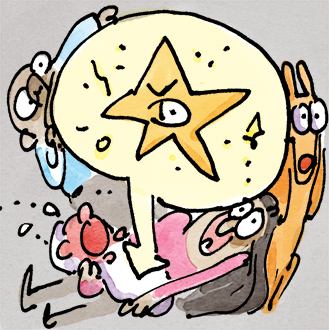Coliques, pleurs excessifs et comment les calmer
Résumé au hachoir
- Seuls 5 à 10 % des pleurs excessifs semblent dus à un problème digestif
- S’il n’y a pas de problème digestif, on peut :
- Le facteur les plus important reste le soutien parental, ne pas rester seul si possible
- Diminuer la consommation de cigarettes et d’alcool si concerné
- Chanter des comptines
- Habituer le bébé au cycle jour-nuit
- Répondre rapidement aux pleurs, la journée
- Des nourrissages plus fréquents
- Essayer de se calmer
- L’efficacité du portage reste controversée
A quel moment peut-on parler de colique du nourrisson ?
Les coliques du nourrisson se caractérisent principalement par des pleurs inconsolables qui commencent et s’achèvent sans avertissements, mais plusieurs définitions existent1,2. Le principal type de colique appelée « colique de Wessel » se caractérise par la règle des trois : l’enfant pleure plus de trois heures par jour, pendant plus de trois jours par semaine, pendant plus de trois semaines3,4. Les autres définitions incluent d’autres symptômes comme des pleurs haut perchés, de l’hypertonie (poings fermés, jambes fléchies, grimaces, abdomen distendu), des flatulences, de la régurgitation ou de la diarrhée1.
Dépendant de la définition choisie et du type de population observée, le taux de prévalence varie de 2 à 40 % de la population4–7. De plus, il semble que ces coliques du nourrisson portent bien mal leur nom car, d’après plusieurs études, seuls 5 à 10 % de ces pleurs semblent dus à un problème digestif (du style intolérance au lait de vache, etc.)1,2.
Quelles options s’il y a un problème digestif ?
Lorsqu’il y a un problème digestif, il est conseillé de consulter un médecin. Celui-ci pourra prescrire plusieurs types de traitement.
Les traitements liés à un changement de régime alimentaire ont démontré leur efficacité8–13. Pour les mères allaitantes, ils consistent généralement à réduire les allergènes comme le lait de vache, les œufs, les noix, le blé, le soja et le poisson12. Pour les mères non allaitantes, le médecin peut prescrire des probiotiques ou des préparations plus hydrolysées de lait 8–13.
Concernant l’efficacité de traitements alternatifs comme les suppléments naturels ou les infusions de menthe, fenouil, camomille, verveine, mélisse, réglisse, les quelques études s’y étant intéressées suggèrent des effets positifs, mais elles sont encore trop rares pour conclure avec certitude sur leurs effets14–19. De même, les études concernant les traitements physiques du type ostéopathie, acuponcture ou massage (thérapie craniosacrale et réflexologie), suggèrent aussi des effets positifs, mais sont encore trop rares pour conclure de manière certaine quant à leurs avantages ou leurs risques sur le long terme20–24.
Quelles options s’il n’y a pas de problème digestif ?
Lorsque l’intolérance au lactose n’est pas concernée, il semble que ces pleurs excessifs reflètent juste le point extrême d’une variabilité normale. Tout simplement, certains bébés pleurent en moyenne beaucoup plus que les autres29. Chez ces bébés, les chercheurs n’ont constaté aucune différence dans le rythme cardiaque, le tonus vagal et les niveaux de cortisol (hormone qui reflète le niveau de stress)30.
Mais que faire dans ces cas-là pour prévenir et/ou calmer les crises de pleurs ? Plusieurs comportements ont été identifiés.
- Chanter des comptines semble retarder la crise de pleurs31.
- Si vous êtes concernés, diminuer la consommation de cigarettes et d’alcool. Certaines études ont montré que des pleurs excessifs sont plus probables chez les bébés exposés à la fumée de cigarette pendant la grossesse ou après la naissance32,33. La fumée augmente les niveaux de motiline, une hormone induisant des contractions intestinales douloureuses33. La fumée est aussi liée à des problèmes de sommeil qui peuvent contribuer à l’irritabilité du bébé34,35. Enfin, d’autres études ont montré que l’exposition à l’alcool pendant la grossesse ou pendant l’allaitement altère aussi le développement du cerveau, augmentant les risques d’irritabilité et d’anxiété36,37.
- Habituer le bébé au cycle jour-nuit en l’exposant davantage à la lumière naturelle et en évitant les lumières artificielles la nuit. Ceci semble diminuer les problèmes de sommeil38–43, ainsi que ceux de digestion44. (Voir le chapitre dédié au sommeil pour en savoir plus.)
- D’autres études suggèrent que la promptitude à répondre aux pleurs diminue leur quantité45,46.
- L’efficacité du portage reste controversée. Il semble que la quantité et la durée des pleurs diminuent globalement47–49; mais ce n’est pas toujours répliqué50 et cela pourrait augmenter les réveils nocturnes48. Aussi, même si prendre un bébé dans les bras a tendance à le calmer, cela recommence souvent quand on le repose51.
- Des tétées ou des nourrissages plus fréquents réduisent globalement le nombre et la durée des pleurs52–55.
- Essayer de se calmer et sourire, car le stress semble contagieux même pour les bébés36,56.
- Enfin, un des facteurs les plus importants reste le soutien parental. La plupart des recherches sur les pleurs ont été faites chez des Occidentaux où les parents, souvent les mères, passent de longues heures seuls avec leurs bébés. Cet isolement peut augmenter l’anxiété chez certains parents, ce qui peut en retour impacter le bébé et favoriser les pleurs excessifs36,57–62. C’est d’ailleurs aussi valable pendant la grossesse63–65. Davantage de soutien pour le parent (conjoint, grands-parents, amis, infirmière à domicile …), de même qu’avoir plusieurs figures d’attachement pour le bébé ont par ailleurs été corrélés à des bienfaits cognitifs et émotionnels évidents pour le bébé66–73. Tous ces facteurs ont été confirmés par des études interculturelles, notamment avec des tribus de chasseurs-cueilleurs dont les bébés pleurent jusqu’à deux fois moins que les bébés occidentaux74–76.
Pourquoi des pleurs excessifs sont-ils si rares chez les chasseurs-cueilleurs ?
Les coliques du nourrisson semblent extrêmement rares chez eux. Reflétant très bien la littérature décrite précédemment, ces cultures se caractérisent par :
- une absence de lait de vache. Les chasseurs-cueilleurs n’en boivent pas, ce qui peut du coup limiter les coliques chez les 10 % de bébés concernés ;
- une meilleure habituation du bébé au cycle jour-nuit, en exposant davantage le bébé à la lumière naturelle et en évitant les lumières artificielles la nuit ;
- une haute réactivité aux complaintes de leurs bébés (92 % de réponses se font dans les 15 secondes qui suivent leur gigotement)75,77,78 ;
- un portage presque constant de leurs bébés (supérieur à plus de 80 % de la journée, ce qui facilite la haute réactivité aux complaintes, on est d’accord ! )74,75,79 ;
- des tétées à la demande (jusqu’à quatre fois par heure)74,75,79. Les tétées sont généralement courtes, ce qui pourrait prévenir les régurgitations et aider le bébé à digérer ;
- enfin, chez les chasseurs-cueilleurs, les parents ne sont pratiquement jamais seuls avec les bébés. Non seulement il y a souvent d’autres personnes autour, mais les adultes ainsi que les jeunes enfants savent en général consoler un bébé qui pleure et peuvent jouer facilement les babysitters75,80,81. Les autres adultes sont généralement extrêmement tolérants face à un bébé qui pleure76. Tout cela pourrait permettre aux parents de faire une ou plusieurs siestes la journée, au cas où le bébé aurait passé une mauvaise nuit.
Références
1 Gormally, S.M. and Barr, R.G. (1997) ‘Of clinical pies and clinical clues: proposal for a clinical approach to complaints of early crying and colic’. Ambulatory Child Health, 3, pp. 137–153.
2 Lehtonen, L., Gormally, S. and Barr, R.G. (2000) ‘Outcome in infants presenting with early increased crying’, in Crying as a Sign, a Symptom, and a Signal: Clinical, Emotional and Developmental Aspects of Infant and Toddler Crying, Cambridge University Press, p. 67.
3 Wessel, Morris A., Cobb, John C., Jackson, Edith B., Harris, George S. and Detwiler, Ann C. (1954) ‘Paroxysmal Fussing in Infancy, Sometimes Called “Colic”’. Pediatrics, 14(5), pp. 421–435. [online] Available from: http://pediatrics.aappublications.org/content/14/5/421 (Accessed 25 January 2018)
4 Reijneveld, Sijmen A., Brugman, Emily and Hirasing, Remy A. (2001) ‘Excessive Infant Crying: The Impact of Varying Definitions’. Pediatrics, 108(4), pp. 893–897. [online] Available from: http://pediatrics.aappublications.org/content/108/4/893 (Accessed 25 January 2018)
5 Canivet, Catarina, Jakobsson, Irene and Hagander, Barbro (2002) ‘Colicky Infants According to Maternal Reports in Telephone Interviews and Diaries: A Large Scandinavian Study’. Journal of Developmental & Behavioral Pediatrics, 23(1), p. 1. [online] Available from: https://journals.lww.com/jrnldbp/Abstract/2002/02000/Colicky_Infants_According_to_Maternal_Reports_in.1.aspx (Accessed 25 January 2018)
6 Lucassen, P. L. B. J., Assendelft, W. J. J., Eijk, J. Th M. van, Gubbels, J. W., et al. (2001) ‘Systematic review of the occurrence of infantile colic in the community’. Archives of Disease in Childhood, 84(5), pp. 398–403. [online] Available from: http://adc.bmj.com/content/84/5/398 (Accessed 25 January 2018)
7 Søndergaard, Charlotte, Skajaa, Elisabeth and Henriksen, Tine Brink (2000) ‘Fetal growth and infantile colic’. Archives of Disease in Childhood - Fetal and Neonatal Edition, 83(1), pp. F44–F47. [online] Available from: http://fn.bmj.com/content/83/1/F44 (Accessed 25 January 2018)
8 Kanabar, D., Randhawa, M. and Clayton, P. (2001) ‘Improvement of symptoms in infant colic following reduction of lactose load with lactase’. Journal of Human Nutrition and Dietetics, 14(5), pp. 359–363. [online] Available from: http://onlinelibrary.wiley.com/doi/10.1046/j.1365-277X.2001.00304.x/abstract (Accessed 25 January 2018)
9 Iacovou, Marina, Ralston, Robin A., Muir, Jane, Walker, Karen Z. and Truby, Helen (2012) ‘Dietary Management of Infantile Colic: A Systematic Review’. Maternal and Child Health Journal, 16(6), pp. 1319–1331. [online] Available from: https://link.springer.com/article/10.1007/s10995-011-0842-5 (Accessed 25 January 2018)
10 Johnson, J. D., Cocker, K. and Chang, E. (2015) ‘Infantile Colic: Recognition and Treatment.’ American family physician, 92(7), pp. 577–582. [online] Available from: http://europepmc.org/abstract/med/26447441 (Accessed 25 January 2018)
11 Freedman, Stephen B., Al-Harthy, Nesrin and Thull-Freedman, Jennifer (2009) ‘The Crying Infant: Diagnostic Testing and Frequency of Serious Underlying Disease’. Pediatrics, 123(3), pp. 841–848. [online] Available from: http://pediatrics.aappublications.org/content/123/3/841 (Accessed 25 January 2018)
12 Hill, David J., Roy, Neil, Heine, Ralf G., Hosking, Clifford S., et al. (2005) ‘Effect of a Low-Allergen Maternal Diet on Colic Among Breastfed Infants: A Randomized, Controlled Trial’. Pediatrics, 116(5), pp. e709–e715. [online] Available from: http://pediatrics.aappublications.org/content/116/5/e709 (Accessed 25 January 2018)
13 Egervarn, Maria, Danielsen, Morten, Roos, Stefan, Lindmark, Hans and Lindgren, Sven (2007) ‘Antibiotic Susceptibility Profiles of Lactobacillus reuteri and Lactobacillus fermentum’. Journal of Food Protection, 70(2), pp. 412–418. [online] Available from: http://www.jfoodprotection.org/doi/abs/10.4315/0362-028X-70.2.412 (Accessed 25 January 2018)
14 Alves, João Guilherme Bezerra, Brito, De, Moraes, Rita de Cássia Coelho and Cavalcanti, Telma Samila (2012) ‘Effectiveness of Mentha piperita in the Treatment of Infantile Colic: A Crossover Study’. Evidence-Based Complementary and Alternative Medicine. [online] Available from: https://www.hindawi.com/journals/ecam/2012/981352/abs/ (Accessed 25 January 2018)
15 Weizman, Zvi, Alkrinawi, Soliman, Goldfarb, Dan and Bitran, Chaim (1993) ‘Efficacy of herbal tea preparation in infantile colic’. The Journal of Pediatrics, 122(4), pp. 650–652. [online] Available from: http://www.sciencedirect.com/science/article/pii/S0022347605835577 (Accessed 25 January 2018)
16 Alexandrovich, I., Rakovitskaya, O., Kolmo, E., Sidorova, T. and Shushunov, S. (2003) ‘The effect of fennel (Foeniculum Vulgare) seed oil emulsion in infantile colic: a randomized, placebo-controlled study.’ Alternative therapies in health and medicine, 9(4), pp. 58–61. [online] Available from: http://europepmc.org/abstract/med/12868253 (Accessed 25 January 2018)
17 Savino, Francesco, Cresi, Francesco, Castagno, Emanuele, Silvestro, Leandra and Oggero, Roberto (2005) ‘A randomized double?blind placebo?controlled trial of a standardized extract of Matricariae recutita, Foeniculum vulgare and Melissa officinalis (ColiMil®) in the treatment of breastfed colicky infants’. Phytotherapy Research, 19(4), pp. 335–340. [online] Available from: http://onlinelibrary.wiley.com/doi/10.1002/ptr.1668/full (Accessed 25 January 2018)
18 Duygu, Arikan, Handan, Alp, Gözüm, Sebahat, Orbak, Zerrin and Karaca Çifçi, Esra (2008) ‘Effectiveness of massage, sucrose solution, herbal tea or hydrolysed formula in the treatment of infantile colic’. Journal of Clinical Nursing, 17(13), pp. 1754–1761. [online] Available from: http://onlinelibrary.wiley.com/doi/10.1111/j.1365-2702.2007.02093.x/full (Accessed 25 January 2018)
19 Perry, Rachel, Hunt, Katherine and Ernst, Edzard (2011) ‘Nutritional Supplements and Other Complementary Medicines for Infantile Colic: A Systematic Review’. Pediatrics, p. peds.2010-2098. [online] Available from: http://pediatrics.aappublications.org/content/early/2011/03/28/peds.2010-2098 (Accessed 25 January 2018)
20 Dobson, Dawn, Lucassen, Peter, Miller, Joyce, Vlieger, Arine, et al. (2014) ‘Manipulative Therapies for Infantile Colic’. The Journal of Alternative and Complementary Medicine, 20(5), pp. A114–A114. [online] Available from: http://online.liebertpub.com/doi/full/10.1089/acm.2014.5303.abstract (Accessed 25 January 2018)
21 Landgren, Kajsa, Kvorning, Nina and Hallström, Inger (2010) ‘Acupuncture reduces crying in infants with infantile colic: a randomised, controlled, blind clinical study’. Acupuncture in Medicine, p. acupmed2394. [online] Available from: http://aim.bmj.com/content/early/2010/10/18/aim.2010.002394 (Accessed 25 January 2018)
22 Skjeie, Holgeir, Skonnord, Trygve, Fetveit, Arne and Brekke, Mette (2013) ‘Acupuncture for infantile colic: A blinding-validated, randomized controlled multicentre trial in general practice’. Scandinavian Journal of Primary Health Care, 31(4), pp. 190–196. [online] Available from: https://doi.org/10.3109/02813432.2013.862915 (Accessed 25 January 2018)
23 Castejón-Castejón, M., Murcia-González, M. A., Martínez Gil, J. L., Todri, J., et al. (2019) ‘Effectiveness of craniosacral therapy in the treatment of infantile colic. A randomized controlled trial’. Complementary Therapies in Medicine, 47, p. 102164. [online] Available from: http://www.sciencedirect.com/science/article/pii/S0965229918309452 (Accessed 20 February 2020)
24 Hannula, L, Puukka, P., Asunmaa, M. and Mäkijärvi, M. (n.d.) ‘A pilot study of parents’ experiences of reflexology treatment for infants with colic in Finland’. Scandinavian Journal of Caring Sciences, (n/a), p. 2019. [online] Available from: https://onlinelibrary.wiley.com/doi/abs/10.1111/scs.12790 (Accessed 20 February 2020)
25 Garrison, Michelle M. and Christakis, Dimitri A. (2000) ‘A Systematic Review of Treatments for Infant Colic’. Pediatrics, 106(Supplement 1), pp. 184–190. [online] Available from: http://pediatrics.aappublications.org/content/106/Supplement_1/184 (Accessed 25 January 2018)
26 Goldman, Martin and Beaumont, Tricia (2017) ‘A real world evaluation of a treatment for infant colic based on the experience and perceptions of 4004 parents’. British Journal of Nursing, 26, pp. S3–S10.
27 Williams, J and Watkins-Jones, R (1984) ‘Dicyclomine: worrying symptoms associated with its use in some small babies’. British Medical Journal, 288(6421), p. 901. [online] Available from: https://www.ncbi.nlm.nih.gov/pmc/articles/PMC1441710/ (Accessed 25 January 2018)
28 Moore, David John, Tao, Billy Siang-Kuo, Lines, David Robin, Hirte, Craig, et al. (2003) ‘Double-blind placebo-controlled trial of omeprazole in irritable infants with gastroesophageal reflux’. The Journal of Pediatrics, 143(2), pp. 219–223. [online] Available from: http://www.sciencedirect.com/science/article/pii/S0022347603002075 (Accessed 25 January 2018)
29 Soltis, J. (2004) ‘The signal functions of early infant crying’. Behavioral and Brain Sciences, 27(04), pp. 443–458. [online] Available from: href=”http://dx.doi.org/10.1017/S0140525X0400010X
30 White, Barbara Prudhomme, Gunnar, Megan R., Larson, Mary C., Donzella, Bonny and Barr, Ronald G. (2000) ‘Behavioral and Physiological Responsivity, Sleep, and Patterns of Daily Cortisol Production in Infants with and without Colic’. Child Development, 71(4), pp. 862–877. [online] Available from: http://onlinelibrary.wiley.com/doi/10.1111/1467-8624.00196/abstract (Accessed 26 January 2018)
31 Corbeil, Mariève, Trehub, Sandra E. and Peretz, Isabelle (2015) ‘Singing Delays the Onset of Infant Distress’. Infancy, 21(3), pp. 373–391. [online] Available from: http://onlinelibrary.wiley.com/doi/10.1111/infa.12114/abstract (Accessed 26 January 2018)
32 Reijneveld, Sijmen A, Lanting, Caren I, Crone, Mathilde R and van Wouwe, Jacobus P (2005) ‘Exposure to tobacco smoke and infant crying’. Acta Pædiatrica, 94(2), pp. 217–221. [online] Available from: http://onlinelibrary.wiley.com/doi/10.1111/j.1651-2227.2005.tb01894.x/abstract (Accessed 26 January 2018)
33 Shenassa, Edmond D. and Brown, Mary-Jean (2004) ‘Maternal Smoking and Infantile Gastrointestinal Dysregulation: The Case of Colic’. Pediatrics, 114(4), pp. e497–e505. [online] Available from: http://pediatrics.aappublications.org/content/114/4/e497 (Accessed 26 January 2018)
34 Mennella, Julie A., Yourshaw, Lauren M. and Morgan, Lindsay K. (2007) ‘Breastfeeding and Smoking: Short-term Effects on Infant Feeding and Sleep’. Pediatrics, 120(3), pp. 497–502. [online] Available from: http://pediatrics.aappublications.org/content/120/3/497 (Accessed 26 January 2018)
35 Pesonen, Anu-Katriina, Räikkönen, Katri, Matthews, Karen, Heinonen, Kati, et al. (2009) ‘Prenatal Origins of Poor Sleep in Children’. Sleep, 32(8), pp. 1086–1092. [online] Available from: https://academic.oup.com/sleep/article/32/8/1086/2679666 (Accessed 26 January 2018)
36 Lemola, Sakari, Stadlmayr, Werner and Grob, Alexander (2009) ‘Infant irritability: The impact of fetal alcohol exposure, maternal depressive symptoms, and low emotional support from the husband’. Infant Mental Health Journal, 30(1), pp. 57–81. [online] Available from: http://onlinelibrary.wiley.com/doi/10.1002/imhj.20203/abstract (Accessed 26 January 2018)
37 Kraemer, Gary W., Moore, Colleen F., Newman, Timothy K., Barr, Christina S. and Schneider, Mary L. (2008) ‘Moderate Level Fetal Alcohol Exposure and Serotonin Transporter Gene Promoter Polymorphism Affect Neonatal Temperament and Limbic-Hypothalamic-Pituitary-Adrenal Axis Regulation in Monkeys’. Biological Psychiatry, 63(3), pp. 317–324. [online] Available from: http://www.sciencedirect.com/science/article/pii/S0006322307007299 (Accessed 26 January 2018)
38 Jenni, Oskar G. and Carskadon, Mary A. (2007) ‘Sleep Behavior and Sleep Regulation from Infancy through Adolescence: Normative Aspects’. Sleep Medicine Clinics, 2(3), pp. 321–329. [online] Available from: http://www.sleep.theclinics.com/article/S1556-407X(07)00050-1/abstract (Accessed 28 January 2018)
39 Akacem, Lameese D., Simpkin, Charles T., Carskadon, Mary A., Jr, Kenneth P. Wright, et al. (2015) ‘The Timing of the Circadian Clock and Sleep Differ between Napping and Non-Napping Toddlers’. PLOS ONE, 10(4), p. e0125181. [online] Available from: http://journals.plos.org/plosone/article?id=10.1371/journal.pone.0125181 (Accessed 26 January 2018)
40 Cho, YongMin, Ryu, Seung-Hun, Lee, Byeo Ri, Kim, Kyung Hee, et al. (2015) ‘Effects of artificial light at night on human health: A literature review of observational and experimental studies applied to exposure assessment’. Chronobiology International, 32(9), pp. 1294–1310. [online] Available from: https://doi.org/10.3109/07420528.2015.1073158 (Accessed 26 January 2018)
41 Iwata, Sachiko, Fujita, Fumie, Kinoshita, Masahiro, Unno, Mitsuaki, et al. (2017) ‘Dependence of nighttime sleep duration in one-month-old infants on alterations in natural and artificial photoperiod’. Scientific Reports, 7, p. 44749. [online] Available from: https://www.nature.com/articles/srep44749 (Accessed 28 January 2018)
42 Wehr, T. A., Moul, D. E., Barbato, G., Giesen, H. A., et al. (1993) ‘Conservation of photoperiod-responsive mechanisms in humans’. American Journal of Physiology-Regulatory, Integrative and Comparative Physiology. [online] Available from: http://www.physiology.org/doi/abs/10.1152/ajpregu.1993.265.4.R846 (Accessed 26 January 2018)
43 Weissbluth, M. and Weissbluth, L. (1992) ‘Colic, sleep inertia, melatonin and circannual rhythms’. Medical Hypotheses, 38(3), pp. 224–228. [online] Available from: http://www.sciencedirect.com/science/article/pii/030698779290099X (Accessed 28 January 2018)
44 Weissbluth, L. and Weissbluth, M. (1992) ‘Infant colic: The effect of serotonin and melatonin circadian rhythms on the intestinal smooth muscle’. Medical Hypotheses, 39(2), pp. 164–167. [online] Available from: http://www.medical-hypotheses.com/article/0306-9877(92)90180-K/abstract (Accessed 28 January 2018)
45 Miller, Patrice Marie and Commons, Michael Lamport (2010) ‘The benefits of attachment parenting for infants and children: A behavioral developmental view.’ Behavioral Development Bulletin, 16(1), pp. 1–14.
46 Bell, S. M. and Ainsworth, M. D. S. (1972) ‘Infant crying and maternal responsiveness’. Child Development, 43(4), pp. 1171–1190.
47 Hunziker, Urs A. and Barr, Ronald G. (1986) ‘Increased Carrying Reduces Infant Crying: A Randomized Controlled Trial’. Pediatrics, 77(5), pp. 641–648. [online] Available from: http://pediatrics.aappublications.org/content/77/5/641 (Accessed 26 January 2018)
48 St James-Roberts, I, Conroy, S and Wilsher, K (1998) ‘Links between maternal care and persistent infant crying in the early months’. Child: Care, Health and Development, 24(5), pp. 353–376. [online] Available from: http://doi.wiley.com/10.1046/j.1365-2214.2002.00089.x (Accessed 5 December 2017)
49 Lee, Keun (2000) ‘Crying and behavior pattern in breast- and formula-fed infants’. Early Human Development, 58(2), pp. 133–140. [online] Available from: http://www.sciencedirect.com/science/article/pii/S0378378200000712 (Accessed 28 January 2018)
50 Barr, Ronald G., McMullan, Sara J., Spiess, Heinz, Leduc, Denis G., et al. (1991) ‘Carrying as Colic “Therapy”: A Randomized Controlled Trial’. Pediatrics, 87(5), pp. 623–630. [online] Available from: http://pediatrics.aappublications.org/content/87/5/623 (Accessed 26 January 2018)
51 Esposito, Gianluca, Yoshida, Sachine, Ohnishi, Ryuko, Tsuneoka, Yousuke, et al. (2013) ‘Infant Calming Responses during Maternal Carrying in Humans and Mice’. Current Biology, 23(9), pp. 739–745. [online] Available from: http://www.cell.com/current-biology/abstract/S0960-9822(13)00343-6 (Accessed 26 January 2018)
52 Engler, Anat Cohen, Hadash, Amir, Shehadeh, Naim and Pillar, Giora (2012) ‘Breastfeeding may improve nocturnal sleep and reduce infantile colic: Potential role of breast milk melatonin’. European Journal of Pediatrics, 171(4), pp. 729–732. [online] Available from: https://link.springer.com/article/10.1007/s00431-011-1659-3 (Accessed 26 January 2018)
53 Blass, Elliott M. (1997) ‘Infant Formula Quiets Crying Human Newborns’. Journal of Developmental & Behavioral Pediatrics, 18(3), p. 162. [online] Available from: https://journals.lww.com/jrnldbp/Abstract/1997/06000/Infant_Formula_Quiets_Crying_Human_Newborns.4.aspx (Accessed 26 January 2018)
54 Howard, Cynthia R., Lanphear, Nancy, Lanphear, Bruce P., Eberly, Shirley and Lawrence, Ruth A. (2006) ‘Parental Responses to Infant Crying and Colic: The Effect on Breastfeeding Duration’. http://www.liebertpub.com/bfm. [online] Available from: http://online.liebertpub.com/doi/abs/10.1089/bfm.2006.1.146 (Accessed 26 January 2018)
55 Barr, Ronald G. and Elias, Marjorie F. (1988) ‘Nursing Interval and Maternal Responsivity: Effect on Early Infant Crying’. Pediatrics, 81(4), pp. 529–536. [online] Available from: http://pediatrics.aappublications.org/content/81/4/529 (Accessed 28 January 2018)
56 Waters, Sara F., West, Tessa V. and Mendes, Wendy Berry (2014) ‘Stress Contagion: Physiological Covariation Between Mothers and Infants’. Psychological Science, 25(4), pp. 934–942. [online] Available from: https://doi.org/10.1177/0956797613518352 (Accessed 26 January 2018)
57 Cutrona, Carolyn E. and Troutman, Beth R. (1986) ‘Social Support, Infant Temperament, and Parenting Self-Efficacy: A Mediational Model of Postpartum Depression’. Child Development, 57(6), pp. 1507–1518. [online] Available from: http://www.jstor.org/stable/1130428 (Accessed 26 January 2018)
58 Crockenberg, Susan and McCluskey, Karen (1986) ‘Change in Maternal Behavior during the Baby’s First Year of Life’. Child Development, 57(3), pp. 746–753. [online] Available from: http://www.jstor.org/stable/1130351 (Accessed 26 January 2018)
59 Stifter, C. A., Bono, M. and Spinrad, T. (2003) ‘Parent characteristics and conceptualizations associated with the emergence of infant colic’. Journal of Reproductive and Infant Psychology, 21(4), pp. 309–322. [online] Available from: https://doi.org/10.1080/02646830310001622123 (Accessed 28 January 2018)
60 Leahy-Warren, Patricia, McCarthy, Geraldine and Corcoran, Paul (2012) ‘First-time mothers: social support, maternal parental self-efficacy and postnatal depression’. Journal of Clinical Nursing, 21(3–4), pp. 388–397. [online] Available from: http://onlinelibrary.wiley.com/doi/10.1111/j.1365-2702.2011.03701.x/abstract (Accessed 26 January 2018)
61 Akman, I., Ku?çu, K., Özdemir, N., Yurdakul, Z., et al. (2006) ‘Mothers’ postpartum psychological adjustment and infantile colic’. Archives of Disease in Childhood, 91(5), pp. 417–419. [online] Available from: http://adc.bmj.com/content/91/5/417 (Accessed 28 January 2018)
62 Howell, Elizabeth A., Mora, Pablo and Leventhal, Howard (2006) ‘Correlates of Early Postpartum Depressive Symptoms’. Maternal and Child Health Journal, 10(2), p. 149. [online] Available from: https://link.springer.com/article/10.1007/s10995-005-0048-9 (Accessed 28 January 2018)
63 Wurmser, Harald, Rieger, Margarete, Domogalla, Caroline, Kahnt, Anja, et al. (2006) ‘Association between life stress during pregnancy and infant crying in the first six months postpartum: A prospective longitudinal study’. Early Human Development, 82(5), pp. 341–349. [online] Available from: http://www.sciencedirect.com/science/article/pii/S0378378205002136 (Accessed 28 January 2018)
64 Holm, Ragnhild and Lien, Katrine Eltvik (2012) ‘Prenatal Psychosocial Risk Factors for the Development of Postpartum Depression’. [online] Available from: https://bora.uib.no/handle/1956/6428 (Accessed 26 January 2018)
65 Rautava, P., Helenius, H. and Lehtonen, L. (1993) ‘Psychosocial predisposing factors for infantile colic.’ BMJ, 307(6904), pp. 600–604. [online] Available from: http://www.bmj.com/content/307/6904/600 (Accessed 28 January 2018)
66 van IJzendoorn, Marinus H, Sagi, Abraham and Lambermon, Mirjam WE (1992) ‘The multiple caretaker paradox: Data from Holland and Israel’. New Directions for Child and Adolescent Development, 1992(57), pp. 5–24.
67 Spieker, Susan J and Bensley, Lillian (1994) ‘Roles of living arrangements and grandmother social support in adolescent mothering and infant attachment’. Developmental Psychology, 30(1), p. 102.
68 Furstenberg, Frank F (1976) Unplanned parenthood: The social consequences of teenage childbearing, New York, NY, US, Free Press.
69 Pope, Sandra K, Whiteside, Leanne, Brooks-Gunn, Jeanne, Kelleher, Kelly J, et al. (1993) ‘Low-birth-weight infants born to adolescent mothers: Effects of coresidency with grandmother on child development’. Journal of the American Medical Association, 269(11), pp. 1396–1400.
70 Olds, David L, Sadler, Lois and Kitzman, Harriet (2007) ‘Programs for parents of infants and toddlers: recent evidence from randomized trials’. Journal of child psychology and psychiatry, 48(3?4), pp. 355–391.
71 Lyons-Ruth, Karlen, Connell, David B., Grunebaum, Henry U. and Botein, Sheila (1990) ‘Infants at Social Risk: Maternal Depression and Family Support Services as Mediators of Infant Development and Security of Attachment’. Child Development, 61(1), pp. 85–98. [online] Available from: http://onlinelibrary.wiley.com/doi/10.1111/j.1467-8624.1990.tb02762.x/abstract (Accessed 26 January 2018)
72 Perner, Josef, Ruffman, Ted and Leekam, Susan R. (1994) ‘Theory of Mind Is Contagious: You Catch It from Your Sibs’. Child Development, 65(4), pp. 1228–1238. [online] Available from: http://onlinelibrary.wiley.com/doi/10.1111/j.1467-8624.1994.tb00814.x/full (Accessed 28 January 2018)
73 Luby, Joan L., Barch, Deanna M., Belden, Andy, Gaffrey, Michael S., et al. (2012) ‘Maternal support in early childhood predicts larger hippocampal volumes at school age’. Proceedings of the National Academy of Sciences, 109(8), pp. 2854–2859. [online] Available from: http://www.pnas.org/content/109/8/2854 (Accessed 28 January 2018)
74 Barr, Ronald G., Konner, Melvin, Bakeman, Roger and Adamson, Lauren (1991) ‘Crying in?!kung San Infants: A Test of the Cultural Specificity Hypothesis’. Developmental Medicine & Child Neurology, 33(7), pp. 601–610. [online] Available from: http://onlinelibrary.wiley.com/doi/10.1111/j.1469-8749.1991.tb14930.x/abstract (Accessed 28 January 2018)
75 Konner, M. (2005) ‘Hunter-gatherer infancy and childhood’, in Hunter-gatherer childhoods: Evolutionary, developmental and cultural perspectives, pp. 19–64.
76 Fouts, Hillary N., Lamb, Michael E. and Hewlett, Barry S. (2004) ‘Infant crying in hunter-gatherer cultures’. Behavioral and Brain Sciences, 27(4), pp. 462–463. [online] Available from: https://www.cambridge.org/core/journals/behavioral-and-brain-sciences/article/infant-crying-in-huntergatherer-cultures/680FEE1D6B66C956C5B7C49F2A0415CC (Accessed 28 January 2018)
77 Konner, M. J. (1972) ‘Aspects of the developmental ethology of a foraging people.’, in Ethological studies of child behaviour., Oxford, England, Cambridge U. Press, pp. x, 400–x, 400.
78 Konner, M. (1977) ‘Infancy among the Kalahari desert San’, in Culture and infancy: Variations in the human experience, pp. 287–328.
79 Konner, M. and Worthman, C. (1980) ‘Nursing frequency, gonadal function, and birth spacing among?!Kung hunter-gatherers’. Science, 207(4432), pp. 788–791. [online] Available from: http://science.sciencemag.org/content/207/4432/788 (Accessed 28 January 2018)
80 Kramer, K. L. (2005) ‘Children’s help and the pace of reproduction: cooperative breeding in humans’. Evolutionary Anthropology: Issues, News, and Reviews, 14(6), pp. 224–237.
81 Kruger, A. and Konner, M. (2010) ‘Who responds to crying?’ Human Nature, 21(3), pp. 309–329. [online] Available from: http://dx.doi.org/10.1007/s12110-010-9095-z
Date de dernière mise à jour : 02/11/2021






